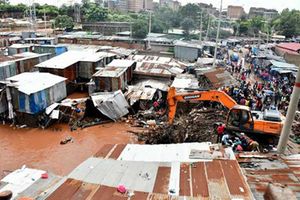
Nairobi residents walk along Tom Mboya Street on August 10, 2021.
| Francis Nderitu | Nation Media GroupNews
Premium
Study reveals shocking Kenya Covid figures
Nearly 50 per cent of blood donors aged between 16 and 64 have had previous exposure to Covid-19, a study has established.
A National Serosurveillance of Kenyan Blood Donors conducted by Kemri-Wellcome Trust between January and March 2021 indicates 48 per cent of people who donated blood during this period had previous exposure to coronavirus.
Serosurveillance projects antibody levels against infectious diseases and is considered a reliable measure of population immunity due to past infection or vaccination.
The findings, the experts said, could be an indication that the number of people who have contracted the virus in Kenya may have been underestimated.
No symptoms
The donors, researchers say, could have been infected with Covid-19 but never got to know about it or did not show any symptoms.
The number of blood donors who had previous exposure varied little by age or sex, but was higher in Nairobi (61.8 per cent) and lower in Nyanza and Western regions.
In August last year, researchers at Kemri Wellcome Trust in Kilifi revised the number of Kenyans exposed to the virus from 2.7million top 1.6 million following further analysis of antibody tests.
This was based on a study carried out on samples of blood donated by Kenyans aged 15 to 64 years between April 30 and June 16, 2020.
"The prevalence of SARS-CoV-2 antibodies in blood donors in Kenya increased from 4.3 per cent to 48.5 per cent over one year. This is consistent with estimates in other Kenyan populations: 11 per cent among antenatal clinic attendees in rural Kilifi and 50 per cent among clinic attendees in urban Nairobi in August to September 2020; 42 per cent among truckers in August to November 2020; and 12 per cent to13 per cent among healthcare workers in rural counties and 44 per cent among healthcare workers in Nairobi in July to December 2020,” the authors wrote.
Dr Ahmed Kalebi, a consultant pathologist in Nairobi, says based on this study, the infection numbers may have been under-determined.
While antibody tests may not be used for diagnostic purposes, he said, there are individual cases where a patient may have all the symptoms, forcing the medics to do an antibody test, which may reveal the actual status.
Test
“The gold standard for Covid-19 test is the polymerase chain reaction (PCR) test, which is used to detect a virus. However, individual antibody tests can be taken when a patient for example shows all the symptoms but the virus is undetected in the PCR test,” he said.
Dr Majid Twahir, the Medical Director at Premier Hospital, Mombasa, however, said chances of missing out on a number of people who are infected is not in doubt.
“Whatever method we use, we underestimate the prevalence of Covid-19. There are those that are asymptomatic or those that have not seroconverted following an illness. Bottom line is that we should continue taking necessary precautions until we are all vaccinated,” he said.
The study by Kemri-Wellcome Trust shows blood donor samples differed from the general population of individuals aged 16 to 64, where 8.0 per cent of blood donors were aged 45 to 64 versus 19.5 per cent of the population.
A majority of the donors were female at (78.1 per cent) versus 49.2 per cent of the population.
Antibodies are proteins created by the immune system that help in fighting off infections. They are made after one has been infected or vaccinated against an infection.
A positive antibody test result shows one may have antibodies from a previous infection or from vaccination for the virus that causes Covid-19.
In October 2020, Kemri-Wellcome Trust revealed that the first epidemic period in Kenya was predominantly in the urban settings, less so the semi-urban counties and least in rural counties.
The researchers managed to find the antibodies through what is known as IgG antibodies. This is because IgG antibodies persist for at least several months in most persons after recovery.
There were 1,145 samples (37.4 per cent) from the transfusion centre in Nairobi, 879 (28.7 per cent) from Mombasa, 431 (14.1 per cent) from Kisumu, 250 (8.2 per cent) from Embu, 200 (6.5 per cent) from Nakuru and 157 (5.1 per cent) from Eldoret.
Forty-four samples were excluded because of missing information, age-ineligible donors or having been collected before 2021.





